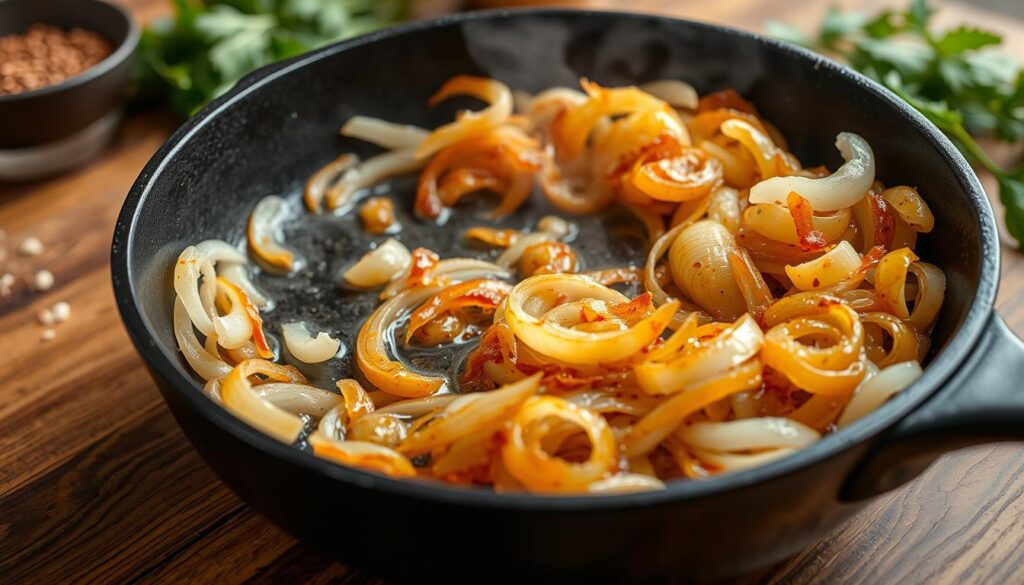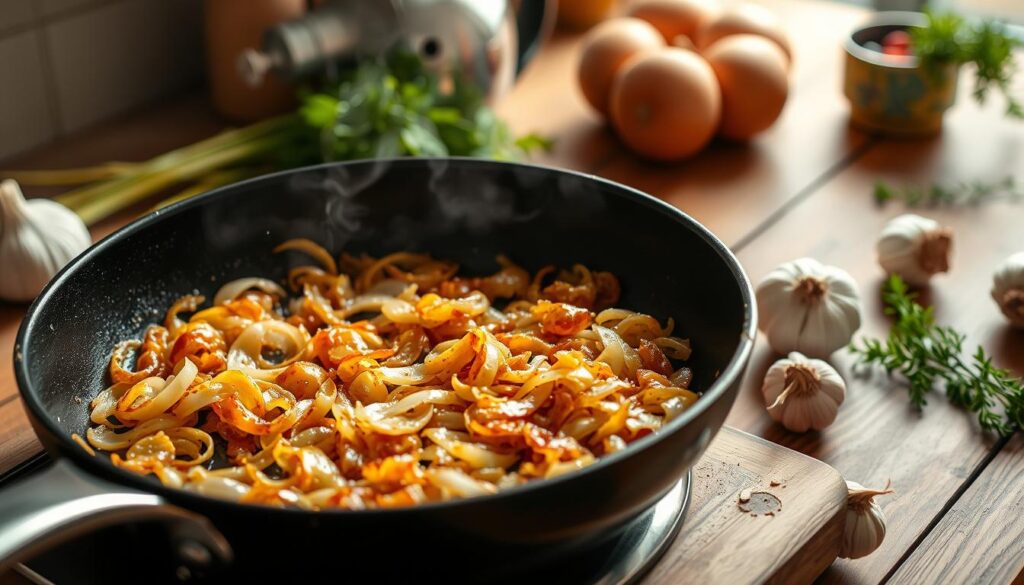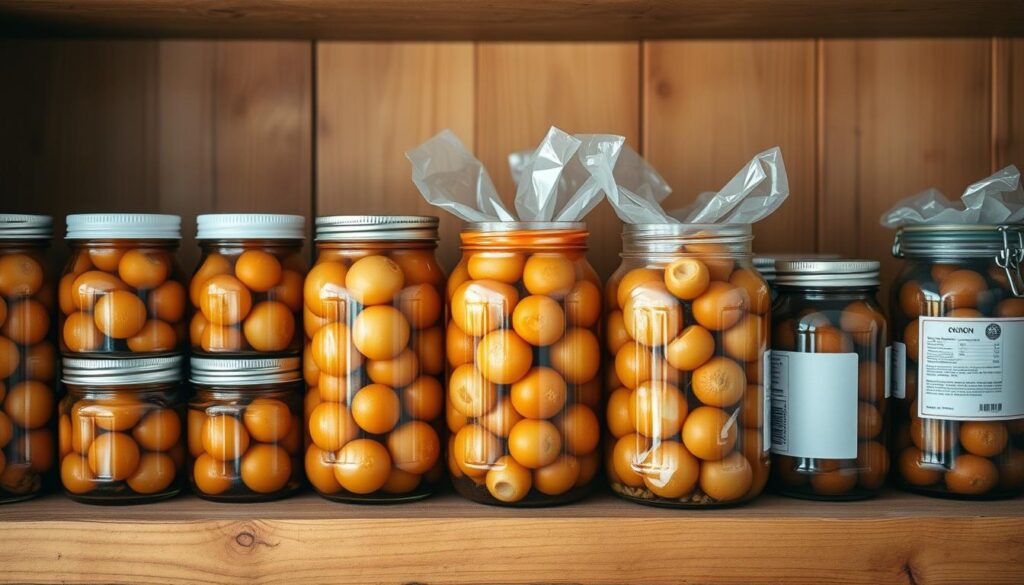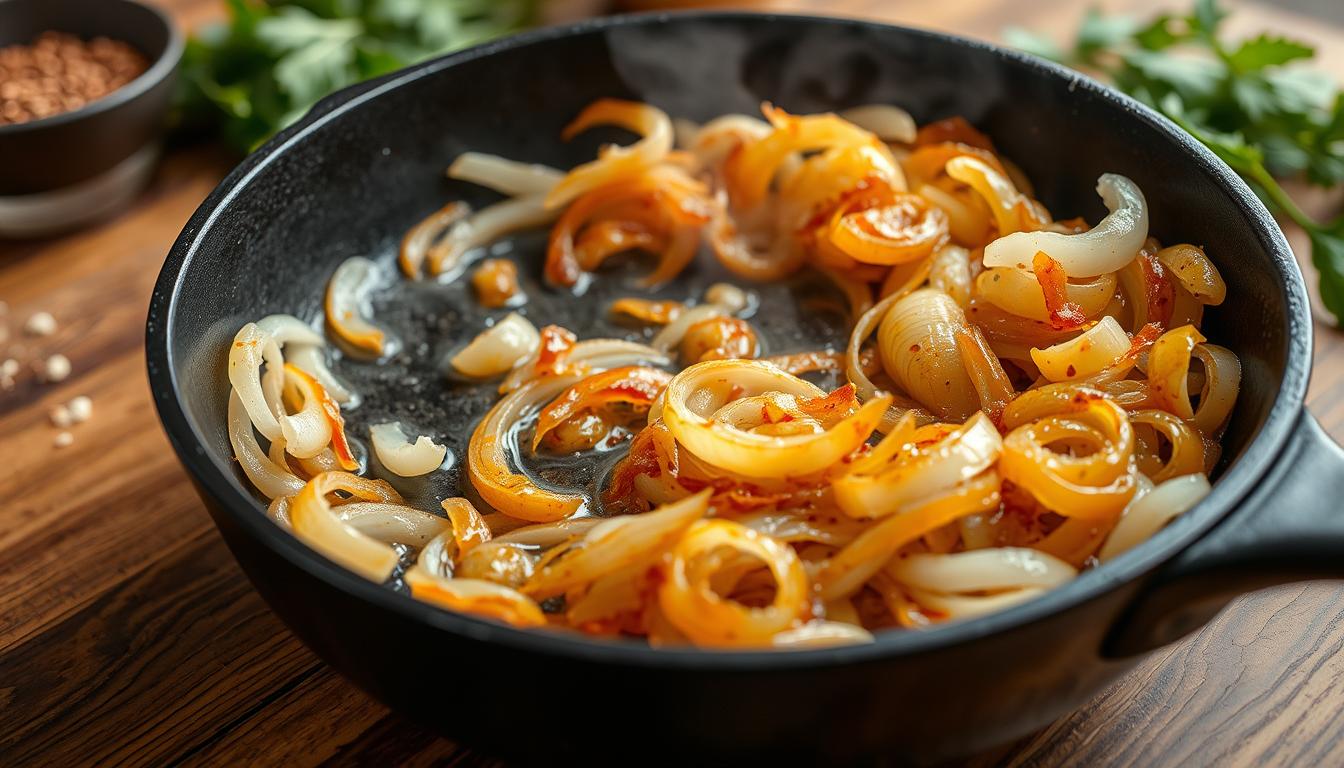
Every great chef knows the magic of caramelizing onions. The first moments fill the kitchen with a sweet, rich aroma. It’s like turning ordinary ingredients into something extraordinary.
Caramelizing onions is more than a cooking technique; it’s an art. It requires patience, understanding, and kitchen intuition. Whether it’s for a French onion soup or a gourmet burger, mastering caramelizing onions adds depth to your dishes.
This guide will teach you how to turn humble onions into golden, sweet delicacies. You’ll learn the science behind caramelization and practical techniques to save time. Soon, you’ll be a pro at browning onions.
Key Takeaways
- Caramelizing onions takes 30-60 minutes for optimal results
- Slice onions uniformly to ensure even caramelization
- Use a combination of butter and oil for best flavor
- Low and slow cooking is crucial for perfect caramelization
- Proper pan selection impacts the caramelization process
Understanding the Science Behind Caramelizing Onions
Caramelization turns simple onions into a sweet, rich delicacy. It’s a complex process that changes their structure and flavor. When you start sweating or sautéing onions, you kick off this amazing transformation.
The Chemical Process of Caramelization
Caramelization breaks down onions’ natural sugars with heat. At around 300°F, their sugars oxidize. This creates new molecules with a sweet, nutty flavor.
- Sucrose transforms into simpler sugars
- Flavor compounds multiply exponentially
- Color changes from translucent to golden brown
Natural Sugars in Different Onion Varieties
| Onion Type | Sugar Content | Flavor Profile |
|---|---|---|
| Sweet Onions | High | Mellow, bright finish |
| Yellow Onions | Medium | Balanced sweetness |
| Red Onions | Low | Deeper, slightly bitter |
The Role of Heat and Time in Caramelization
Patience is key when caramelizing onions. Optimal results require approximately 30-60 minutes of cooking. Quick methods often miss the mark on flavor and color.
“Caramelization is not just cooking, it’s a delicate art of transforming simple ingredients into culinary magic.”
Essential Tools and Ingredients for Perfect Caramelization
To make delicious slow cooking onions, you need the right tools and ingredients. Your journey to making perfect onion jam starts with understanding the essential tools. These tools turn ordinary onions into a culinary masterpiece.
- Wide, heavy-bottomed skillet (cast iron or stainless steel)
- Sharp chef’s knife
- High-quality cooking fats
- Optional deglazing liquids
The ideal pan for slow cooking onions distributes heat evenly. It also provides ample surface area. A cast iron skillet works best. It allows consistent temperature control and prevents hot spots that could burn your onions.
*”The right pan is like a canvas for culinary art – it sets the stage for perfect caramelization.”*
When choosing cooking fats, mix butter and olive oil. The butter adds rich flavor, while olive oil prevents burning. Use about 2 tablespoons of fat per 2 large onions for the best results.
| Ingredient | Quantity | Purpose |
|---|---|---|
| Butter | 1 tablespoon | Flavor enhancement |
| Olive Oil | 1 tablespoon | Preventing burning |
| Salt | Pinch | Flavor extraction |
Pro tip: Keep a small amount of liquid (water or wine) nearby for deglazing. This technique helps lift caramelized bits from the pan. It intensifies the flavor of your onion jam.
The Art of Proper Onion Preparation
Learning how to prepare onions for caramelization is key. It can make your french onion soup or braised onions truly stand out. The right techniques can turn simple onions into a rich, flavorful base for many dishes.
Choosing the Perfect Onions
Not all onions are the same when it comes to caramelizing. Yellow onions are the top choice for their deep flavor and high sugar content. Vidalia onions are sweeter, and white onions can be used if needed.
- Yellow onions: Best for deep, rich caramelization
- Vidalia onions: Naturally sweeter option
- White onions: Acceptable alternative
Mastering Slicing Techniques
It’s important to slice onions evenly for even caramelization. Each slice should be about ⅛ inch thick. This is thin enough to cook well but still keeps the onion’s shape.
Pro tip: Sharp knife and steady hand are your best tools for perfect onion preparation.
Optimal Thickness Guidelines
| Slice Thickness | Cooking Performance |
|---|---|
| ⅛ inch | Ideal for even caramelization |
| ¼ inch | Slower cooking, potential uneven browning |
| 1/16 inch | Risk of burning, quick breakdown |
By following these guidelines, you’ll be well on your way to making delicious caramelized onions. These onions can elevate your french onion soup or braised onions into a true culinary delight.
Mastering the Caramelizing Onions Process
Turning ordinary onions into a sweet, rich delicacy takes patience and precision. This process transforms them into a culinary masterpiece. It’s perfect for your next caramelized onion tart or onion confit.

Start by choosing the right ingredients and tools. Sweet yellow onions like Vidalia are best, with natural sugars that add depth of flavor. Use a mandoline slicer to cut your onions into uniform slices, aiming for medium thickness for even cooking.
“Slow and steady wins the caramelization race” – Professional Chefs
- Start with low heat (around level 3 on your stove)
- Use salted butter for enhanced flavor
- Keep onion layers 2-3 slices high to prevent overcrowding
- Expect a total cooking time of 45-60 minutes
The cooking process has key stages: 5 minutes of initial stirring, 15 minutes of softening, and 30 minutes of caramelizing. Look for the onions to turn from light brown to deep, rich brown. They’ll become sweet and creamy, making any dish better.
For your onion confit, portion and freeze caramelized onions in ice trays. This makes them easy to use later. They’ll stay fresh in an airtight container for up to 3 months, so you always have them ready.
Common Mistakes to Avoid When Browning Onions
Caramelizing onions might seem easy, but many face challenges. Knowing what to avoid can make a big difference.
Getting good at caramelizing onions means avoiding a few big mistakes. These mistakes can mess up the taste and texture.
Temperature Control Challenges
One big mistake is not controlling the heat right. Cooking onions too hot can burn them, losing their sweet flavor.
- Maintain medium-low heat throughout caramelization
- Avoid temperatures above 300°F (149°C)
- Watch for color changes indicating proper caramelization
Timing and Patience Factors
Don’t rush the caramelizing onions process. It takes about 60-70 minutes to get them just right.
| Cooking Stage | Recommended Time | Stirring Frequency |
|---|---|---|
| Initial Softening | 17 minutes | Every 3-5 minutes |
| Browning Phase | 40-50 minutes | Every 1-2 minutes |
Pan Selection Errors
The wrong pan can ruin your caramelizing onions. Pick the right one for even heat and best results.
- Use heavy-bottomed skillets
- Select pans with wide cooking surfaces
- Avoid overcrowding the pan
“Patience is the secret ingredient in perfect caramelized onions.” – Professional Chef
By avoiding these common mistakes, you can turn simple onions into a delicious treat.
Advanced Techniques for Faster Caramelization
When time is of the essence, mastering quick caramelization techniques can transform your cooking. Sweating onions is the first step to achieving rich, golden flavor without spending hours in the kitchen.
Professional chefs have discovered several advanced methods to speed up the caramelization process. Sautéing onions with a pinch of baking soda can dramatically reduce cooking time. This technique works by increasing the pH level, which accelerates the Maillard reaction responsible for developing deep, complex flavors.
“The secret to faster caramelization is understanding the science behind the process.”
- Use baking soda sparingly (just a tiny pinch)
- Start with high heat, then reduce
- Utilize pressure cooker methods
- Slice onions uniformly for even cooking
Alternative techniques can help you achieve golden-brown onions quickly:
- Pressure Cooker Method: Reduces caramelization time by 75%
- High Heat Technique: Initial high temperature followed by gentle reduction
- Pureed Approach: Breaking down onions can cut cooking time dramatically
Remember that while these methods can speed up caramelization, patience remains key to developing deep, rich flavors. Experiment with different techniques to find your perfect balance between speed and taste.
Enhancing Flavors with Additional Ingredients
To turn slow cooking onions into a dish to remember, you need more than just time. The right mix of ingredients can make your caramelized onions truly special. This creates a rich onion jam that will excite your taste buds.
Butter and Oil Combinations
Using different fats can bring out deeper flavors. Mixing olive oil with butter is a great way to cook onions. The butter adds a rich taste, while olive oil stops burning and adds a subtle twist.
- Olive oil prevents butter from burning
- Butter contributes deep, nutty undertones
- Ratio: 2 parts butter to 1 part olive oil works best
Seasoning and Aromatic Enhancements
Choosing the right seasonings can change your caramelized onions. Adding fresh herbs and spices brings new flavors without overpowering the onions’ sweetness.
| Herb/Spice | Flavor Profile | Best Used With |
|---|---|---|
| Thyme | Earthy, slightly minty | Red meats, stews |
| Rosemary | Piney, intense | Roasted vegetables |
| Bay Leaf | Subtle, complex | Soups, sauces |
Deglazing for Depth
Deglazing your pan adds amazing depth to your onions. Cabernet Franc wine is especially good, adding rich fruit and herb flavors.
The secret to an exceptional onion jam lies in the quality of your deglazing liquid.
Try different liquids like red wine, balsamic vinegar, or vegetable broth for unique tastes. Remember, caramelized onions shrink a lot while cooking. So, start with more than you think you’ll need.
Storage and Preservation Methods

Storing your caramelized onions right is key. Whether for a french onion soup or braised onions, the right storage can keep them fresh longer.
For short-term, refrigeration is a quick fix. Keep them in an airtight container for up to a week. For longer, freezing is the way to go.
Freezing Techniques
- Portion onions into small freezer-friendly containers
- Use ice cube trays for individual serving sizes
- Label containers with the date of preparation
- Freeze for up to 3-4 months while maintaining flavor quality
Before freezing, let the onions cool down completely. Spread them in a single layer on a baking sheet first. Then, put them in freezer containers to avoid clumps.
“Proper storage is the secret to maintaining the rich, deep flavor of caramelized onions” – Professional Chef Recommendation
Dehydration Method
Dehydration is great for long-term storage. Slice onions to 1/8 inch and dry for 6-7 hours. Dried onions can last up to a year in glass jars with tight lids.
| Storage Method | Duration | Best Used For |
|---|---|---|
| Refrigeration | Up to 1 week | Quick recipes, french onion soup |
| Freezing | 3-4 months | Braised onions, meal prep |
| Dehydration | Up to 1 year | Long-term storage, snacks |
Learning these storage tips means you’ll always have tasty caramelized onions on hand. They’ll make your dishes even better.
Conclusion
Exploring caramelizing onions has opened up a new world in cooking. You’ve learned how to make a rich caramelized onion tart and a tasty onion confit. Patience and the right techniques are crucial to turn simple onions into a gourmet delight.
The science of caramelization shows that cooking slowly is key. With 30-40 minutes of careful cooking, you can make onions into a flavorful condiment. This can enhance everything from sandwiches to fancy dishes. Cooking at high heat can make onions bitter, but slow cooking brings out their sweetness and color.
Now you can do more than just cook. You know how to choose the right pan, control the temperature, and mix ingredients. This lets you make caramelized onions that add flavor to grilled cheese, mushroom tarts, and many other dishes. Using olive oil or butter is important, but keeping the heat low is the main thing.
As you keep practicing, you’ll see that caramelizing onions is more than a skill. It’s an art that connects you to old cooking ways and opens up new creative paths in your kitchen.
FAQ
How long does it actually take to caramelize onions?
It usually takes 45-60 minutes to caramelize onions the old way. But, with tricks like baking soda or careful heat control, you can do it in 20-30 minutes. This way, you still get that rich flavor and color.
What type of onions work best for caramelizing?
Yellow onions are top picks for caramelizing because they’re sweet and have a strong taste. Sweet onions like Vidalia are also good, but they cook faster and taste milder.
Can I caramelize onions in advance?
Yes, you can make caramelized onions ahead of time. Store them in the fridge for up to 5 days or freeze them in small portions for 3 months. This makes them easy to use in many dishes.
Why aren’t my onions caramelizing properly?
Issues like using too much heat, overcrowding, or not stirring enough can cause problems. Use medium-low heat, a wide pan, and stir often to avoid burning and ensure even caramelization.
Can I caramelize onions without butter?
Absolutely, you can use olive oil, vegetable oil, or mix oils instead of butter. While butter adds a rich taste, other oils can also caramelize onions well, especially for those watching their diet.
Is baking soda really helpful in caramelizing onions faster?
Baking soda can speed up caramelization by breaking down onion cells and changing the pH. But, use it carefully as too much can change the onions’ taste.
How thin should I slice onions for caramelization?
Try to slice onions to 1/8 to 1/4 inch thickness. This ensures they cook evenly and prevents some from burning while others stay raw.
What’s the difference between sweating and caramelizing onions?
Sweating means cooking onions slowly until they’re clear but not browned. Caramelizing, on the other hand, cooks them longer at a bit higher heat to get a deep brown color and sweet taste.
Can I caramelize onions in a non-stick pan?
You can, but a heavy-bottomed stainless steel or cast-iron skillet is better. These pans distribute heat better and help create more flavorful fond, which is the browned bits at the bottom.
How do I prevent my onions from burning?
Keep the heat low, stir often, and use a little water, broth, or wine to deglaze the pan if it starts to brown too fast. This stops burning and adds flavor to your onions.

